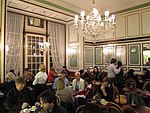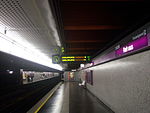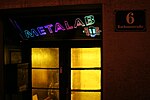Wienbibliothek im Rathaus

The Wienbibliothek im Rathaus (English: Vienna Library in City Hall), formerly known as the Wiener Stadt- und Landesbibliothek (English: Vienna City and State Library), is a library and archive containing important documents related to the history of Vienna, Austria. Founded in 1856, the library, which also contains a large collection of local memorabilia, is located in the Rathaus (City Hall) in the Innere Stadt first district of the city, and is the official library of the city and state of Vienna.The Wienbibliothek preserves 500,000 books, 2,000 newspapers and magazines, 300,000 posters, 500,000 autographs, notable bequests and legacies, and one of the most important music collections in the world. Much of the collection can be retrieved through the online user interface available in both German and English. The library is part of the Magistrat der Stadt Wien (Municipality of Vienna) and supervised by the City Councillor for Culture.
Excerpt from the Wikipedia article Wienbibliothek im Rathaus (License: CC BY-SA 3.0, Authors, Images).Wienbibliothek im Rathaus
City Hall Square, Vienna Innere Stadt
Geographical coordinates (GPS) Address Website Nearby Places Show on map
Geographical coordinates (GPS)
| Latitude | Longitude |
|---|---|
| N 48.211388888889 ° | E 16.3575 ° |
Address
Wien Rathaus
City Hall Square 1
1010 Vienna, Innere Stadt
Austria
Open on Google Maps










